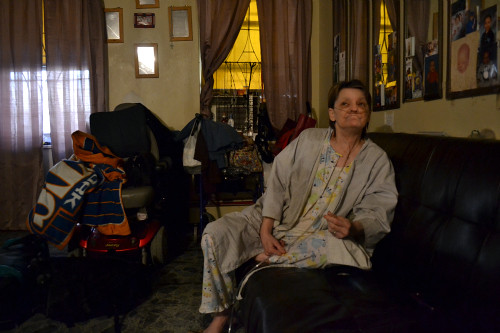 Ian Duncan Ruth Christie at home in her Lower East Side II apartment. Residents of the public housing project complain of damaged facilities and strong smells of sewage.
Ian Duncan Ruth Christie at home in her Lower East Side II apartment. Residents of the public housing project complain of damaged facilities and strong smells of sewage.Ruth Christie was staying in wearing her pajamas and watching movies on VHS. She finds it hard to go out as she must constantly be attached to her oxygen tank to deal with her emphysema.
She has a motorized wheelchair but struggles to maneuver it out of her cramped apartment by herself. “Walking does a number on my breathing,” Ms. Christie, who is 59, said.
Ms. Christie said her condition worsened after she moved to Lower East Side II eight years ago. Residents of LES II complain of dark brown water coming from their taps. When washing machines are running, wastewater finds its way into the pipes, they say.
Residents also complain of intermittent heat and a smell of sewage. As early as February this year the smell was strong and according to Ms. Christie it gets worse most summers.
The Obama Administration turned on the stimulus tap just over two years ago, dedicating funds to improving the quality of public housing. $423 million was given to New York City to fix up its projects. Housing and Urban Development Secretary Shaun Donovan chose the Rutgers Houses on the Lower East Side to announce the New York package in March 2010. “It’s probably the most significant preservation action in the history of public housing,” he said at the time.
Of the total, $1 million reached LES II and was invested in roof repairs. That work was completed last fall. The problem is that what the project probably needs is a new plumbing system, Marquis Jenkins, then a community organizer at Good Old Lower East Side, told the Local in February.
Despite the infusion of cash, residents are required to stump up for many items themselves. Teresa Williams, 52, a neighbor of Ms. Christie, had to pay $27 for a new toilet cistern cover.
LES II, which was built in 1988, spans the block between East Fifth Street and East Sixth Streets between Avenues C and D, with another section between East Fourth Street and East Fifth Street between Avenues B and C. The development has 564 residents according to official City figures, making it the smallest public housing block in the East Village.
From the outside, the squat three-story brick buildings look cheerful, but inside paint is chipped; mail boxes do not lock; stairways are uneven, and doors do not fit properly in their frames. “This one really needs to be condemned and everybody moved out,” Ms. Christie said, referring to her block.
Mr. Jenkins has now left Good Old Lower East Side, but Joel Feingold another community organizer with the group, confirmed that the organization is aware of ongoing problems at LES II and is planning an investigation. The organization is also reviewing extensive surveys of East Village public housing residents.
Good Old Lower East Side has trained residents at other East Village housing projects to fight take complaints to housing court. Ms. Christie said she already took that step last year, and won, but many minor repairs have been left undone.
Tedric Gamble, the manager of LES II, referred The Local to NYCHA’s public relations department. “NYCHA is not aware of any ongoing, serious issues with either the water or sewage at LES II,” Sheila Stainback, a spokeswoman for NYCHA, said by email. “For the last 12 months there were 3 work orders generated for a building stoppage. All repairs were completed the day the complaint was reported.”
LES II was the only East Village project to receive stimulus funds. In total Manhattan received almost $15 million, with the Bronx and Brooklyn benefiting from the lion’s share of the funds. To date, NYCHA has spent 65 percent of the $423,284,344 total, and must expend all its funds by March 2012.



